Menus
- A Monster charm
- Discovery
- In the saddle
- In the city
- Motorway and expressways
- Departmental
- Part-cycle
- Braking
- Comfort / Duo
- Consumption
- Conclusion
- Colors
- Options
- The Ducati Monster 797 video test
A Monster charm
Since its origins, the Monster Desmodue saga has been written in tandem, combining high displacement models (from M900s to M1200s) with a double lower displacement. These younger girls have just as much forged the history of the Bolognese icon. Thus, M600, M620ie, M750 and more recently, M696 and M796 gave access to the myth. Less extreme, they knew how to preserve the flavors. Replacing these last two models, the M821 followed in the sporting footsteps of its eldest, sometimes proving to be more pleasant to ride..
But, very powerful and technological, these new monsters are less accessible, moving away a little from a strict reading of the original concept. Indeed, marketed in 1993, the Mostro M900 laid the foundations for a new motorcycling style: the naked. Edict by Miguel Galluzzi, creator of the Monster, this idea is that everything superfluous must be eliminated: "All you need is: a saddle, a tank, a motor, two wheels and a handlebar".
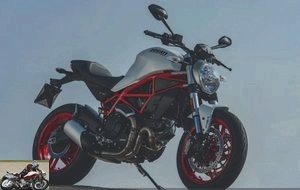
For its 25 years, the stripped roadster, bestseller of the Ducati firm, is therefore available in a more subtle, less bourgeois and sporty version, for ever more charm. The new M797 is one of them, even wanting to be "more Monster than the others" in style according to Stefano Tarabusi, Product Manager of the novelty. For this, Ducati uses the basic codes of its little beast: a Euro 4 approved air-cooled engine, a complete trellis frame and the inimitable style of its creature. No frills, but with an eye for detail. We take control, in the rain, on the French Riviera ….
Discovery
Even more than its predecessors with Testastretta engines, also back to more essentials, the M797 does not bother with superfluity. However, it shares with its half-sisters the codes and certain parts, essentials of the modern Italian motorcycle myth. Thin and barely less muscular, the novelty thus mixes new and original lines, for a great fidelity of filiation. Preceded by a frontal optic common to the family, barred by LEDs and embedded between the fork tubes, its more slender monster build is more elegant. Also, the scoops ahead of the frame and hiding the radiator and regulator elegantly and sportingly dress the sides..
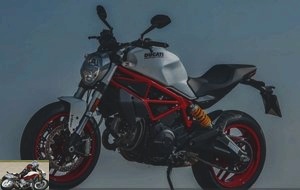
Particularly worked, the volumes of the tank of 16.5 liters, borrowed from the M1200, always sign the particular esthetics of the monster. Soft, the summit curve caps a rather wide element, now cut out by dynamic indentations on the sides, refining the whole. Like the grandmother M900, the bottle is hinged for easy tilting. It is therefore equipped with a fastening loop, identical to that of the 1200, whose typical design is reminiscent of that of ski pumps. In the continuation, a vast one-piece saddle promises a certain comfort, even for the possible passenger. Especially since it benefits from handles formed by the frame tubes.

The latter rediscovers the design of the beginnings: a one-piece tubular steel trellis, running from the steering column to the stern. We are far from the two elements attached to the liquid cooling unit of the 821 and 1200. Here, the structure supports the engine much more. And not just any. A demodue, signing by itself the originality of the 797 model. What a pleasure to see the fins cut out the cylinder housings on a Monster. Because this L-twin 803 cm3 90 °, with desmodromic distribution and two valves per cylinder remains air-cooled, in order to make the most of the retro image. But nothing new. Compliant with Euro4 standards, it is the boiler previously fitted to the M796 and, now, the Scrambler. More info in the Technical article Monster 797.

Particularly neat, the finish of the M797 takes full advantage of the style of its "air" engine and therefore the absence of hoses barring the side of its "liquid" sisters…. Less bulky, the block also refines its lines on the right side, offering a very harmonious whole. Everything is wrapped in the pretty frame cage, with clean and modern lines. All the elements are nicely adjusted and the coating of the metal parts perfectly surfaced. Special mention for the offset shock absorber on the left side, giving the machine a certain sportiness. Likewise, the banana-type swing arm in the style of that of M696 in 2008. We also note the original plates supporting the passenger footrests, taken from the Scrambler. In short, there is no lack of art, and neither is the manner. There are also LED devices for the position lights, rear optics and license plate lighting..
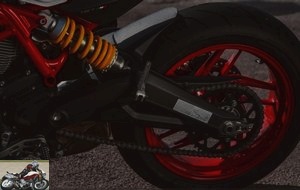
Modernity takes hold of the beautiful, with a USB socket housed under the saddle, to charge smartphones or any device with a suitable connection. As an option, by Bluetooth connection, the Ducati Multimedia System can then control certain functions, manage the music player or receive notifications…. The essential, according to the Italian "dolce vita 2.0".
On the practical side, the maintenance interval is 12,000 km. Finally, announced at 175 kg dry and 193 kg with 90% of the full, the Monster 797 is overweight (M796: 167 kg / 189 kg)
The Monster 797 is eligible for the A2 license after modification, ex works, of the injection body and electronics. Which would make subsequent unlocking expensive…
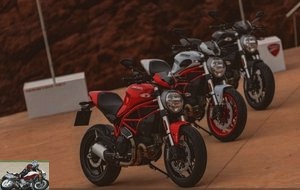
In the saddle
As always, the monster is narrow and accessible, but here still culminates at 805 mm of saddle height, not adjustable. Optional seats allow the standard value to be lowered by 20 mm or increased by 25 units. The ergonomics are more pleasant than on the M821, composing a position just enough of Monster. The handlebars are closer to the rider and the footrests significantly lower and slightly forward. The body therefore barely tilts, lightly resting on the hanger while the legs admit a measured flexion..
On the right hand, we find the starting system with sliding cursor button. A button of the same type is used to control the information on the left stalk. The levers are adjustable in spacing via discreet knobs and press radial master cylinders. Finally, the profiled metal brackets of the mirrors add an extra touch of elegance..
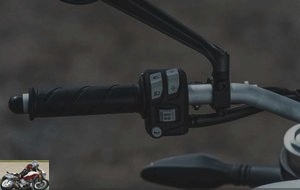
Discreet upper tee and saddles are dominated by a large LCD screen making up the dashboard. A large bar tachometer at the top, under which the tachometer and engine temperature gauge are displayed. And, in two separate frames, we scroll, on the left, odometer, two partials, journey time, clock and on the right and average speed. Despite all this, we despair at the hardly justifiable absence of a gear indicator light and a fuel gauge…. ! A warning command is however present.
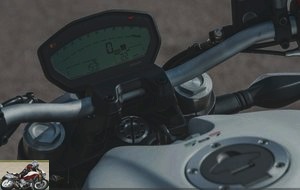
In the city
Euro4 can be "proud" of its work, the monster loses its voice and its mechanical rustling, especially as the exhaust is as discreet as its design on gas strokes. In dynamics, the vocalizations of the L-block are more rumbling and signify more its lineage. On the contrary of its astonishing flexibility. Anyone who knew the demodue and its relative roughness would almost struggle to find it so lovable. A pleasure in urban evolution, the twin air even accepting to evolve in fifth at 2,000 laps or 50 km / h. It is therefore easy to use intermediate reports in town, without knitting the selector. This would not be a problem, because we also note the surprising flexibility of the clutch lever, again very far from the old standards of Bologna.

If the go-arounds in the traffic generate a few jerks, the handle-admission connection is satisfactory. Little inclined to kicks, the beast plays big cats, the accelerator being easy to dose. Softness also predominates in the operation of the gearbox whose reports lock precisely. From the first evolutions, we also find the sensations of Monster driving. Stiffer than that of the competition, the front axle thus translates a rather closed column angle, typical of the Italian roadster. At low speed, the machine becomes docile and the monster is therefore moved very naturally.
The maneuvers are likely to be less pleasant. True homage to the Monsters of the origins, the turning radius is more of the diameter. The weight contained and the narrowness of the machine will still limit the efforts in the U-turn. When you have finished doing the beautiful on the boulevards, take your animal mechanics for a walk.
Motorway and expressways
We were unable to test these tracks during our short test underwater. The Esterel is more profuse in curves than in straight lines, hardly allowing long acceleration. In addition, beyond 7,500 turns the block becomes less pleasant, delivering vibrations without charm. The power then continues its progression in the trepidations of the block which seems seized with frenzy. We prefer to calm down this game that the machine and the pilot do not taste much, the latter quickly making the flag. In legal terms, the mechanics growl nicely at around 5,200 revolutions per minute. But with a wide range of torque available (90% from 4 to 7,500 turns in view of the curves), the mechanics of the Monster are rather an invitation to the secondary network.
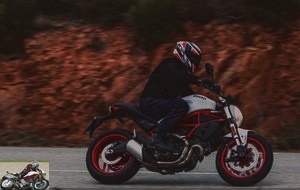
Departmental
Quiet force, the twin here delivers much better rhythmic pulsations, in tune with its entire character, but less sporty. This return to Desmodue takes on its full meaning, giving a specific personality to the Monsterino 2017. The tonic roundness of the block delivers a pleasure of every moment, without having the tonicity of the Testrastretta family. A reasoned choice, especially since the Monster appreciates little improvisation and is then less at ease. Traditionally quite lively on this model, the front axle of the 797 is wiser, but remains sensitive to parasitic movements of the pilot. The relative flexibility of the rear shock absorber also contributes to this feeling if the Ducati is taken without care. And therefore without much interest.
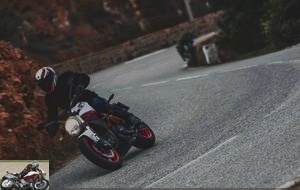
We therefore instinctively resume a piloting on the torque and a casting. Stalled on fourth gear, we then roll up most of the curves without slackening. Because the twin two valves, if it has lost a little of its verve and its authenticity, does not lack life. Its availability is pleasing, relaunching the roadster with authority until the next curve. More expressive at mid-speed, the exhaust accompanies the evolutions in a sympathetic rumble and especially a studied airbox hum. An adaptable silencer will satisfy music lovers more.

Compact with a smaller wheelbase than that of its predecessor, the M797 demonstrates good agility. However, its damping, which is a little too flexible in hydraulics, is sensitive to rapid angle changes. The suspensions then go up too quickly, creating a certain inertia. Fortunately, the Italian is responsive to the pressure on the handlebars, but also on the footrests. And the profile of its Pirelli Diablo Rosso 2 tires, in 180 at the rear, relevant, clearly energizes the behavior. The machine oscillates from one angle to another on the seaside, like a cork in the swell hitting the coast of a rather opalescent azure…. Suffice to say that we do not lose the North on the handlebars of transalpine beast. Typed Monster, but without excess, the steering gear delivers a good feeling of the road and allows an efficient reading of the soggy asphalt. Without reproach in the dry, the grip of the tires is also appreciable in wet driving. However, with its almost 7 da. Nm of torque from its voluntary twin, we regret all the more the absence of anti-slip.
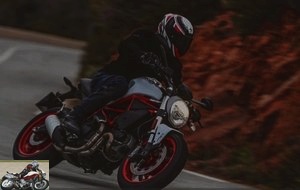
Difficult to say more as the test was on a very wet road. The braking lives up to the family reputation: powerful, but correctly dosed. Taking the lever in a curve immediately straightens the machine. But the rear element delivers good progressivity.
Part-cycle
Original in its tradition, the frame of the M797 is an important component of its style. Rigid and less distinctive than its predecessors, the new opus remains a Monster in its own right, precise, stable and agile.
Braking
Equipped with a high-end reference, the Monsterino allows frank decelerations. These can even be very powerful, but the ABS is vigilant without being intrusive. Powerful, the rear clamp assists the front very well and allows the machine to sit on a curve.
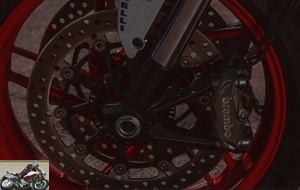
Comfort / Duo
With a more pleasant ergonomics, associated with rather flexible suspensions and a comfortable seat, the Monster 797 is a charming frame. The accompanying person will find correct support with the short passenger handles. Pleasant, they are however placed a little too close to the center of gravity of the passenger, due to a short rear loop, limiting the stability during acceleration..
Of course, the practical aspects always shy away from the machine, which may be one of the qualities of the model for its fans..
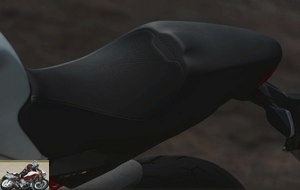
Consumption
Not verified.
Conclusion
Despite a presentation disturbed by the weather, the Ducati Monster 797 reveals a monster and authentic charm. A compendium of family history, it brilliantly combines all its facets. We especially remember the relevance of the return of the Desmodue block associated with the elegance of the trellis frame. Naked roadster devoted to ballads at a more contained pace than that of its half-sisters, the novelty fully plays the card of family tradition while maintaining a contained modernity. Far from the lively temperament of the M821, the M797 remains sportier than its Scrambler cousin, both in line and in chassis performance and equipment. Thus, it asserts its place as a seductive outsider in the range. However, the block loses a little of its personality and the exhaust is quite discreet. The manufacturer did the best with the standards and the result remains very satisfactory.
At € 8,990 in red (+ € 100 in White or Black), the Monster 797 may seem a bit too expensive for its entry-level status and performance. However, its predecessor was billed € 9,650. And the overall quality of the novelty and its equipment softens this observation. Evolving between two segments, dynamic or charming roadster, we will first oppose its sister, the M821 claiming € 11,150 and the cousin Scrambler from € 8,990 to € 11,290. Another stylish European, the Triumph Street Twin benefits from a high-end finish, but admits less dynamism for its € 8,900. Towards the rising sun, the Yamaha XSR700 ABS and XSR900, 7,999 and 9,999 € frame the Italian in price. The first will be less rewarding, the second is undoubtedly superior in dynamics.
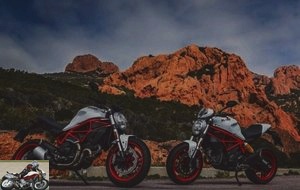
In the end, the price positioning of the Monster 797 seems relevant, the machine being a link between two approaches to the same concept. Qualified as "premium" by Ducati, the M797 can do well in a complicated game, where its style and its mechanics are its best assets. The Bologna firm plans to sell 600 copies over the year. Joker in a competitive segment, the Ducati Monster 797 could play the spoiler.
Strong points
- Elegant and charming aesthetic
- Engine availability
- Agility of the chassis
- Braking
- Ergonomics
- Finishes
Weak points
- Indented engine character (Euro4)
- Decreased sound (Euro4)
- No gear indicator engaged
- No anti-slip
Ducati Monster 797 technical sheet
Colors
- Star White Silk, red frame and rims
- Classic Ducati Red, black frame and rims
- Dark Stealth, black frame and rims
Plus version : nose screen and passenger seat cowl
Options
- Low seat: 202.80 €
- High comfort saddle: 202.80 €
- High passenger handles: € 91
- Passenger seat cowl: 154.80 €
- Wind break: € 262.80
- Dual outlet Termignoni Evoline exhaust: 958 €
- Sport kit: 634 €
Plate holder
LED turn signals
Carbon tank protection
- Comfort Kit: € 502.80
Magnetic tank bag
Passenger handles
Windshield
The Ducati Monster 797 video test
Related articles
-
Light up your dark side The Monster saga has been written since 1993 with its large displacement models M900, M1000 ie, S4R, M1100. But the younger girls…
-
Ducati Scrambler 800 Icon Dark test
Gothic fun attitude L-twin, desmodromic distribution, 54 kW at 8,250 rpm, 189 kg, € 8,850 A successful model, the Ducati Scrambler 800 benefits from its…
-
Authentic sensations Ducati knows how to offer models that transcend its history, such as its Monster, in its range. The success of the latter is based…
-
Monster return to origins Legendary bestseller of the Italian brand, the Monster is renewing itself in efficiency through an essential evolution. Pure…
-
Ducati Scrambler 800 Icon test
Uninhibited rebel L-Twin of 803 cm3, 73 hp and 67 Nm, 189 kg, from 9,350 euros Long the main muse of the Italian manufacturer, the Monster has found an…
-
Ducati Multistrada 1200 motorcycle test
The Italian UFO Appeared in 2003, the first Multistrada model was designed around an air-cooled Desmodue L-twin engine of 992 cm3 then 1078 cm3 in 2006….
-
Ducati Monster 1100 Evo ABS DTC motorcycle test
Darwin’s twin Like all species, the Monster 1100 evolves and keeps only the best in the irresistible race of evolution that began in 1993 with its…
-
V2, 821 cm3, 109 hp at 9,250 rpm, 86 Nm at 7,750 rpm, 180 kilos dry, from 11,450 € Ducati’s mid-size roadster is getting a makeover and fine-tuning the…
-
Naked original 3.0 Legendary bestseller of the Italian brand, the Monster is the archetype of the undressed roadster. Dressed in essentials, the new…
-
Ducati Monster motorcycle test
Salon revolution V-Twin Testastretta of 937 cm3, 111 hp, 93 Nm, 166 kg dry (188 kg full made), 11,290 euros Is a Monster still a Monster if it doesn’t…